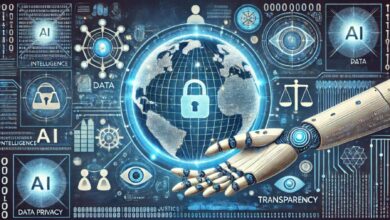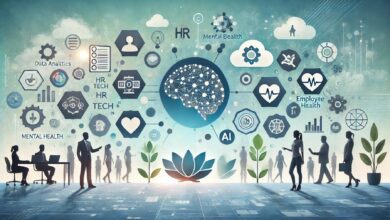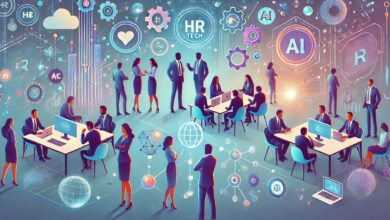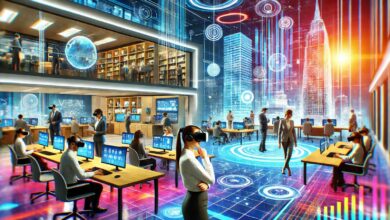
HR technology is no longer just about managing payroll or tracking attendance. The modern landscape demands a more holistic approach, where HR tech serves as the backbone of a company’s Learning & Development (L&D) strategy. In large organizations, personalizing and scaling employee learning is a critical challenge, and traditional, one-size-fits-all training programs fall short. But HR technology is changing the game, enabling L&D to become more dynamic, personalized, and effective.
To unlock the full potential of HR technology in L&D, we need to shift our mindset. This is not about giving the responsibility to a tech specialist or implementing software for the sake of automation. The real power of HR tech lies in collaboration, active listening to employee requirements and keenly helping employees grow. In much the same way SEO works best when integrated with curiosity and a focus on helping users, HR tech thrives when approached with an intent to truly elevate employee skills and learning outcomes.
The core problem is scale. Large organizations often struggle with creating meaningful learning experiences that cater to individual needs while managing thousands of employees. Traditional training programs — generic seminars, fixed content, or workshops — are often ineffective because they don’t speak to the varied learning styles and requirements of different employees.
This is where HR technology steps in. With tools that integrate AI and machine learning, companies can now offer personalized learning paths. Think about OTT platforms (Amazon Prime Video and Netflix) that recommend shows based on your past viewing habits.
In a similar way, L&D platforms can curate training modules based on each employee’s job role, performance, and learning preferences. IT major Infosys has successfully implemented HR tech solutions that allow employees to pick and choose from a vast library of courses, while the platform suggests skills they might want to focus on based on their career trajectory.
Employees get learning experiences tailored to them, and companies see higher engagement rates. No longer is training a chore to be completed — it becomes an interactive, motivating journey of continuous development.
The IT and Tech industry has been leading the charge when it comes to leveraging HR technology for L&D. TCS (Tata Consultancy Services) has led the way. This IT services major faced the challenge of keeping the workforce up-to-date with fast-changing technologies.
TCS employed an AI-powered L&D platform that enabled it to offer personalized learning tracks to over 400,000 staff. These tracks were based not only on their current roles but also on future industry trends, ensuring that employees were always ahead of the curve. Moreover, the platform allowed them to scale this offering across geographies, which was crucial for an organisation of their size.
The most compelling aspect of integrating HR technology into L&D is how data analytics enables real-time feedback and optimization of learning programs. It is known that organisations had to previously rely on program conclusion surveys to measure program effectiveness. HR tech platforms are now leveraging advanced analytics to track employee progress, measure engagement, and even predict learning outcomes.
Technology platforms like Degreed and Cornerstone OnDemand enable HR teams to monitor which training modules employees are engaging with most. How they are performing in assessments, and whether they are applying the skills learned in their day-to-day work.
Organizations can refine their L&D strategies in real time with such insightful data at their finger-tips. Probably a particular module isn’t resonating well with a team, or maybe a certain cohort of employees are excelling in areas outside their current roles. HR tech helps flag these insights, allowing organisations to adjust and fine-tune their learning programs to better align with employee needs and organisational goals.
The future of L&D cannot be imagined without the role of artificial intelligence (AI), machine learning, and automation. Today, AI is already helping to personalize learning journeys, but its future applications are even more exciting. Visualise AI-powered learning assistants that can interact with employees in real time, answering their questions, recommending resources, or even providing on-the-job training through augmented reality (AR) platforms.
Machine learning algorithms could analyse vast amounts of performance data to identify skill gaps that employees aren’t even aware of yet. Based on this data, HR teams could proactively provide training opportunities, preparing the workforce for challenges before they arise. Predictive analytics, meanwhile, will be able to forecast trends in employee development, guiding L&D programs in line with both personal and organizational growth trajectories.
But, all this innovation brings forth a significant challenge of Adoption. Many HR teams are still struggling with integrating this new tech into their L&D programs. This is most often a result of resistance to change or a lack of understanding about how these systems work.
To overcome this, HR leaders need to foster a culture of continuous learning — not just for employees but for the HR department itself. Teams need to be trained on how to use these tools effectively and how to interpret the data they provide.
Implementing HR tech in L&D is not without its hurdles. One of the most common challenges is the fear of technology replacing the human element. Employees may worry that AI and automation will depersonalize their learning experience or lead to a more transactional approach. But, as with any technological advancement, the key is balance.
HR leaders should be transparent about how these technologies are meant to augment, not replace, the human aspects of learning. The goal is to make learning more accessible and personalized, not to strip away the mentorship and hands-on guidance that make L&D meaningful.
Another challenge is the cost and complexity of implementing these systems. While HR tech offers immense value, the upfront investment can be daunting, particularly for smaller organizations. However, the long-term ROI — improved employee engagement, reduced turnover, and higher productivity — more than justifies the cost.
At the heart of this discussion lies a simple truth: HR technology is really a strategy in the garb of a tool. In today’s rapidly evolving workplace, where the pace of change is accelerating, employees need continuous learning opportunities to remain competitive. It is HR technology that provides the infra to deliver these opportunities in a personalized yet scalable way.
By leveraging these technologies thoughtfully, HR leaders can create learning environments that are not only more effective but also more engaging, helping employees build the skills they need to thrive in the future of work.
The future of Learning & Development lies in harnessing the power of HR technology — not to replace the human touch but to elevate it. By listening to employee needs, acting with the intent to help, and using tech to scale and personalize learning, HR teams can create the perfect environment for growth, both for their people and their organizations.










